
© » KADIST
Colter Jacobsen
Victory at Sea is a simple mechanism made from cardboard and found materials that mimics the Phenakistoscope, an early cinematic apparatus. The piece requires the viewer to turn a wheel and look through a small hole in order to see a briefly animated succession of small drawings of sailors.

© » KADIST
Colter Jacobsen
Drawing & Print (Drawing & Print)
The title Untitled Passport II was first used by Felix Gonzalez-Torres in an unlimited edition of small booklets, each containing sequenced photographs of a soaring bird against an open sky. Stacked in the shape of a cube and available for visitors to take away, the passports did not offer citizenship, but rather invited participation in a sense of borderless “being.” Colter Jacobsen’s Untitled (Untitled Passport II) is a diptych showing two-page spreads from Gonzalez-Torres’s booklet. The perfect graphite renderings freeze the book with its pages splayed, wings perpetually open.
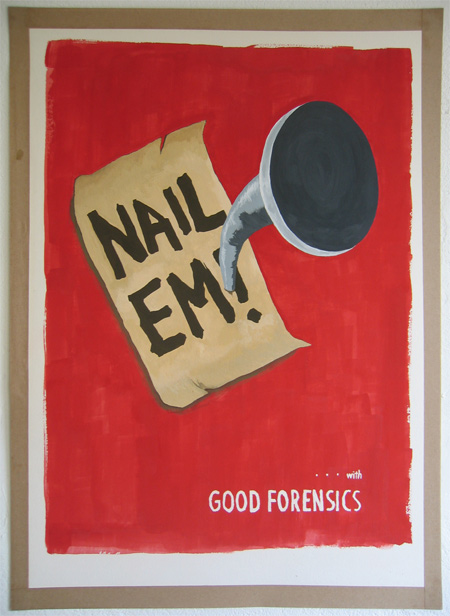
© » KADIST
Mike Cooter
Drawing & Print (Drawing & Print)
Forensic Poster was first realized in 2006 and reactivated in 2011; its making consisted of the artist visiting the London School of Criminology and corresponding with the interim director there in order to reproduce a poster by memory. This piece of work is symptomatic of Cooter’s projects which are often arduous enterprises littered with pitfalls, since they imply prospecting and collaborating with third parties whose will determine the success of the project. Forensic Poster consists of a letter, emails and a gouache which translates the artist’s attempt to recreate a poster glimpsed at in one of the study halls of the London Police Department of Forensic Medicine.

© » KADIST
Julius Koller
Wordplay was a central focus of Koller’s work, in particular the acronym U. F. O, which he adapted in his diagrammatic drawings to stand variously for Univerzálna Futurologická Organizácia (Universal Futurological Organization, 1972–3), Univerzálny Filozoficky Ornament (Universal Philosophical Ornament, 1978) or Underground Fantastic Organization (1975), and which also appeared in a series of slapsticky self-portraits titled ‘U. F. O.–naut’ (1970–2007). These infinite variations on a common cipher constituted an insistent incantation of the Utopian principle.
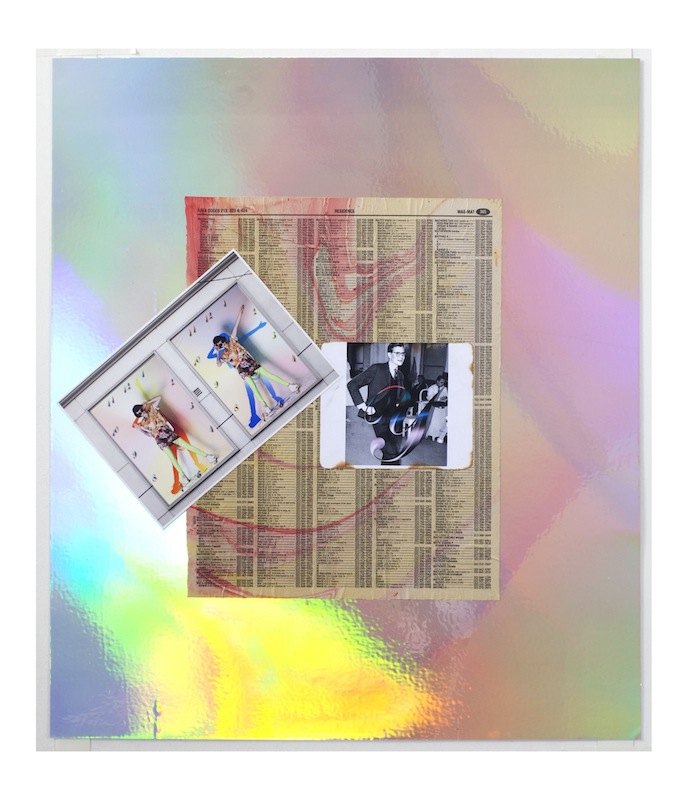
© » KADIST
Carter Mull
Mull’s Worker’s Clock collage works bring together images from the artist’s studio photography practice, found photographs, and pages from a phone book, laying them over a psychedelic warp of color in the background. One of the images is borrowed from a billboard, Double Block (for Alanna Pearl, Nik Nova and R. Mutt) (2013) that Mull created to hang above some storefronts in downtown Los Angeles. The pair of photographs features a woman posed in the center for rings of numbers, her body and shadow taking the place of the mechanical hands.
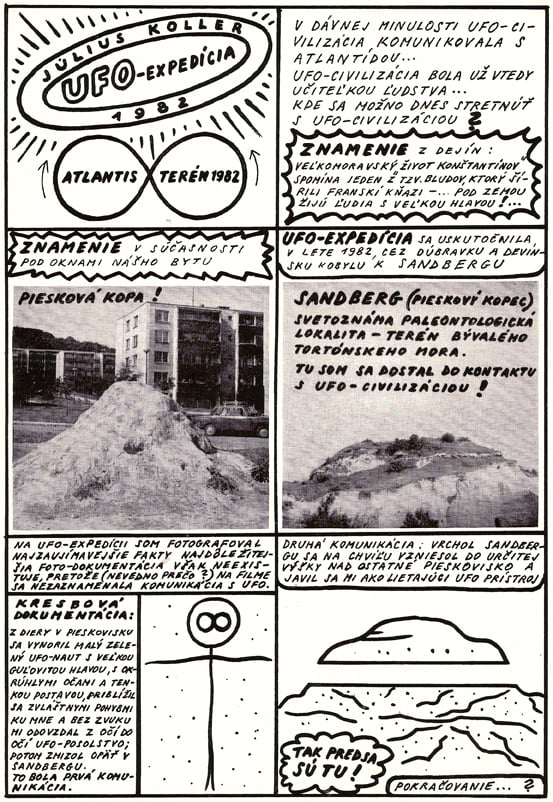
© » KADIST
Julius Koller
Drawing & Print (Drawing & Print)
Wordplay was a central focus of Koller’s work, in particular the acronym U. F. O., which he adapted in his diagrammatic drawings to stand variously for Univerzálna Futurologická Organizácia (Universal Futurological Organization, 1972–3), Univerzálny Filozoficky Ornament (Universal Philosophical Ornament, 1978) or Underground Fantastic Organization (1975), and which also appeared in a series of slapsticky self-portraits titled ‘U. F. O.–naut’ (1970–2007). These infinite variations on a common cipher constituted an insistent incantation of the Utopian principle.

© » KADIST
Carter Mull
Mull’s Worker’s Clock collage works bring together images from the artist’s studio photography practice, found photographs, and pages from a phone book, laying them over a psychedelic warp of color in the background. One of the images is borrowed from a billboard, Double Block (for Alanna Pearl, Nik Nova and R. Mutt) (2013) that Mull created to hang above some storefronts in downtown Los Angeles. The pair of photographs features a woman posed in the center for rings of numbers, her body and shadow taking the place of the mechanical hands.
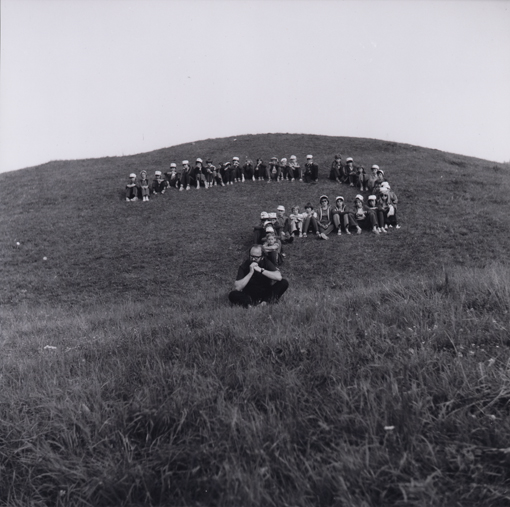
© » KADIST
Julius Koller
This work is one of Koller’s many variations which he began to use from 1970 to describe the ‘cultural situations’ he created. His “Anti-Happenings” turned mundane events into ‘cultural’ and ‘subjective’ situations. He sought to create new cultural situations that weren’t new art, but rather new ways of living: a new creativity for a new humanistic culture.

© » KADIST
Bruce Conner
In 1977, as an already-established artist best known for his films, Bruce Conner began to photograph punk rock shows at Mabuhay Gardens, a San Francisco club and music venue. 27 Punk Photos: 11. Dim Wanker: F Word, May, 1978 (1978) is representative of a series of photographs by Conner, whose subject became a fascination for the artist.

© » KADIST
Keren Cytter
“Untitled” is inspired by the movie “Opening Night” by John Cassavetes with Gena Rowlands playing the role of a fallen woman, anguished by her distressed life. In the film, we witness the drama of a blended family, heightened by adultery and finally murder. For the film’s decor, Cytter, instead of filming a domestic interior, uses a theater stage, a place of representation by excellence.

© » KADIST
Collier Schorr
Collier Schorr’s prints upend conventions of portrait photography by challenging what it means to “document” a subject. American Flag (Scratch) (1999), for example, depicts an unidentified male subject clad in an American flag-print singlet. With his head and extremities out of frame, the camera focuses on his flush-red torso, his left nipple protruding from the singlet’s strap.

© » KADIST
Bruce Conner
Unlike many of his earlier films which often present poignant critiques of mass media and its deleterious effects on American culture, EASTER MORNING , Conner’s final video work before his death in 2008, constitutes a far more meditative filmic essay in which a limited amount of images turn into compelling, almost hypnotic visual experience. The video presents us with a reinterpretation of footage from his unreleased avant-garde film, Easter Morning Raga , from 1966. In contrast to his more famous pieces like A Movie (1958) and Crossroads (1976) which are juxtapositions of fragments from newsreels, soft-core pornography, and B movies, the images in EASTER MORNING serve as a reinterpretation of footage.

© » KADIST
Collier Schorr
In the Collage II (Marie) (2013), Shorr seems to have an ostensibly clear subject, a female subject identified in the work’s title as “Marie,” a slim but athletic woman with brown hair pictured reclining atop a brilliantly white sheet draped against a marbled tan-and-white backdrop. Although photographed topless, Marie is depicted in slightly contorted poses that emphasize the curves of her figure while also obstructing the viewer’s gaze. Printed on high gloss paper, Marie’s portrait has the polished veneer of magazine spread, and the two portraits on display offer different vantages of the same subject.

© » KADIST
Rachel Foster
Rachel E. Foster uses printmaking, sculpture, and photography to illuminate the nearly invisible. For her source material she combs the digital world for bits of strange information that seep into our daily reality. These clues, be they coded sequences or simple phrases, become part of her puzzle; by reframing information she makes us reconsider it through a different lens.

© » KADIST
Volker Eichelmann
In his new series of collages, Eichelmann takes his starting point from the “Belvedere Torso” in the Vatican Museum. In taking over and consuming the image of the sculpture, Eichelmann deconstructs its appearance by cutting it up, covering it, rendering the sculpture an allegorical ruin. Subverting the autonomy of the ancient sculpture in art history, Eichelmann creates a palimpsest through adding a new layer to the work in deconstructing and collapsing the famous sculpture.
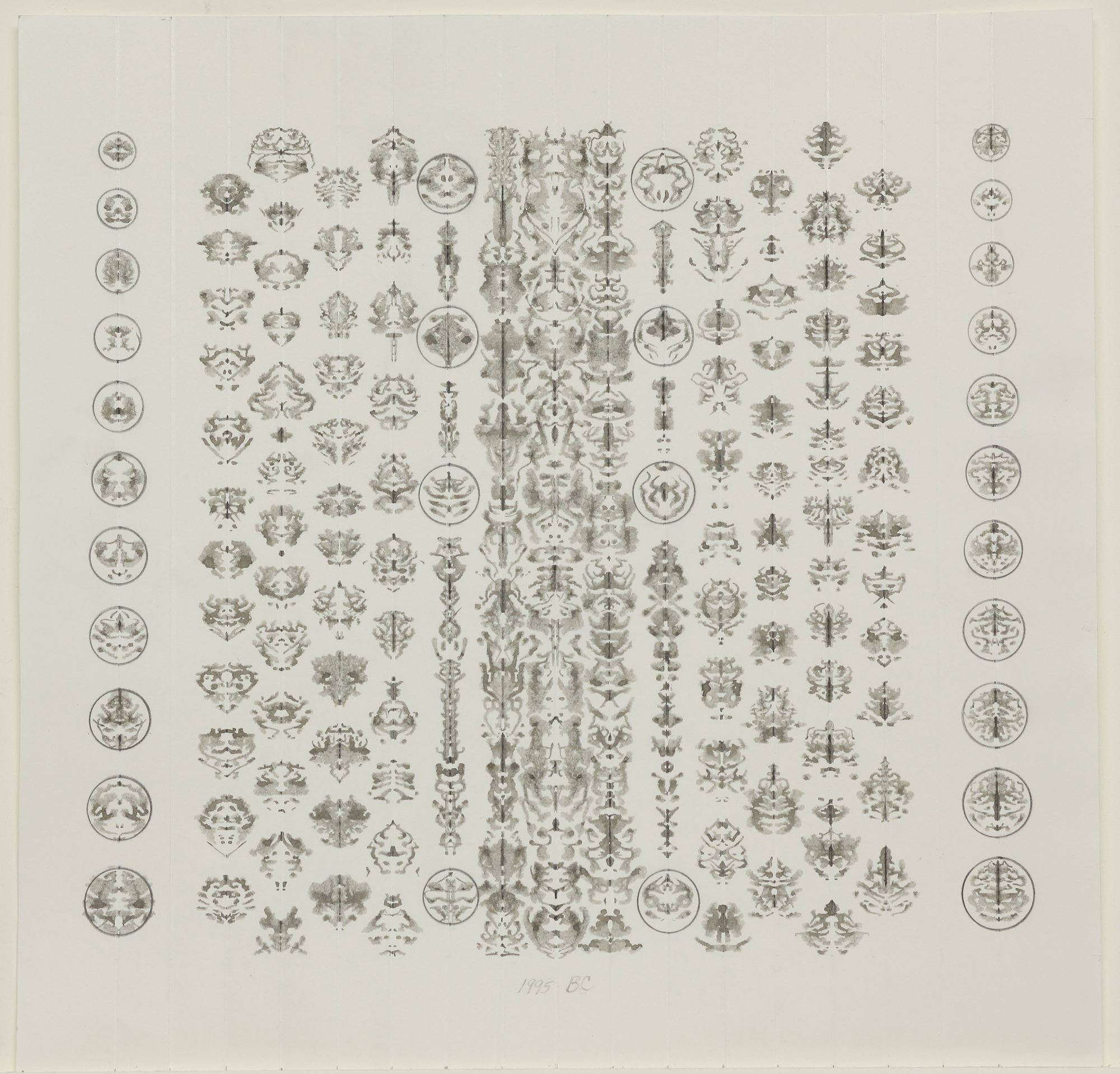
© » KADIST
Bruce Conner
Drawing & Print (Drawing & Print)
Bruce Conner is best known for his experimental films, but throughout his career he also worked with pen, ink, and paper to create drawings ranging from psychedelic patterns to repetitious inkblot compositions. Untitled Inkblot Drawing (CT-1491) (1995) is representative of his aspect of his practice. It is a formal exploration related to many different things: the Rorschach inkblot testing used by psychologists, Japanese calligraphy, Egyptian hieroglyphs, and the intricate patterning Conner saw everywhere in the world around him.
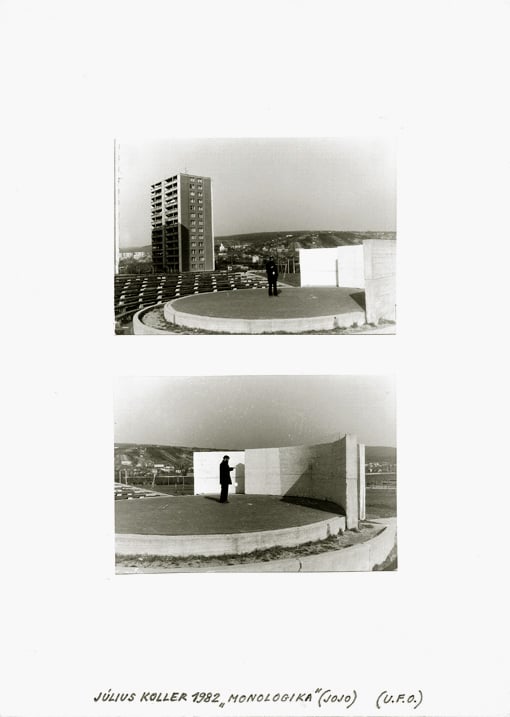
© » KADIST
Julius Koller
The photograph Monologic – Yo-Yo 1, 2 (U. F. O. ), (1982), shows Koller playing with a big white Yo-Yo in a drab concrete building among a group of tower blocks.

© » KADIST
Julius Koller
Drawing & Print (Drawing & Print)
Anti-Happening refers to Koller’s 1965 manifesto, ‘Anti-Happening (System of Subjective Objectivity)’. In opposition to the notion of a ‘happening’ as a way of actualising group identity, in his manifesto, Koller stated that his concept of the ‘anti-happening’ aimed at a ‘cultural reshaping of the subject, at awareness, at the surroundings and the real world’ [i] . Unlike happenings, these actions do not involve the staging of psychologically expressive performances.

© » KADIST
Alex Da Corte
Slow Graffiti was produced for Da Corte’s exhibition at the Vienna Secession in 2017. The video is a shot-for-shot remake of the film “The Perfect Human” by Danish filmmaker Jørgen Leth (1967). The original is narrated in an anthropological manner, or as if listening to a guide at a zoo, but Da Corte’s version is stranger and more philosophical.
Julius Koller
- location: Pieštany, Slovenská Republika
- year born: 1939
- gender: male
- nationality: Slovakian
Bruce Conner
- location: San Francisco, California
- year born: 1933
- gender: male
- nationality: American
- home town: McPherson, Kansas
Colter Jacobsen
Since 2003, Colter Jacobsen has gained in visibility and importance in the Bay Area art scene...
Carter Mull
Los Angeles-based artist Carter Mull is an obsessive sort, and his fascinations show through in his multimedia photographic and installation-based works...
Keren Cytter
Keren Cytter makes films who appropriate and transform different registers, from film noir, melodrama, documentary and television series...
Mike Cooter
Mike Cooter’s practice interrogates the place of the artist in society and his implication in reality, indeed in most of his projects he works with third parties et integrates them into the artistic process...
Alex Da Corte
Alex Da Corte’s works conveys a state of delusion, where logic is set aside in order to access the stranger, deeper parts of our minds...
Volker Eichelmann
Volker Eichelmann (b...
Rachel Foster
Rachel Foster is concerned with showing the unseen...
-
-
1970-1979
Julius Koller
1978This work is one of Koller’s many variations which he began to use from 1970 to describe the ‘cultural situations’ he created...
Bruce Conner
1978In 1977, as an already-established artist best known for his films, Bruce Conner began to photograph punk rock shows at Mabuhay Gardens, a San Francisco club and music venue...
-
1980-1989
Julius Koller
Drawing & Print
1982(Drawing & Print) Wordplay was a central focus of Koller’s work, in particular the acronym U...
-
1990-1999
Bruce Conner
Drawing & Print
1995(Drawing & Print) Bruce Conner is best known for his experimental films, but throughout his career he also worked with pen, ink, and paper to create drawings ranging from psychedelic patterns to repetitious inkblot compositions...
Collier Schorr
1999Collier Schorr’s prints upend conventions of portrait photography by challenging what it means to “document” a subject...
-
2000-2009
Mike Cooter
Drawing & Print
2006(Drawing & Print) Forensic Poster was first realized in 2006 and reactivated in 2011; its making consisted of the artist visiting the London School of Criminology and corresponding with the interim director there in order to reproduce a poster by memory...
Colter Jacobsen
2007Victory at Sea is a simple mechanism made from cardboard and found materials that mimics the Phenakistoscope, an early cinematic apparatus...
Bruce Conner
2008Unlike many of his earlier films which often present poignant critiques of mass media and its deleterious effects on American culture, EASTER MORNING , Conner’s final video work before his death in 2008, constitutes a far more meditative filmic essay in which a limited amount of images turn into compelling, almost hypnotic visual experience...
-
2010-2019
Colter Jacobsen
Drawing & Print
2010(Drawing & Print) The title Untitled Passport II was first used by Felix Gonzalez-Torres in an unlimited edition of small booklets, each containing sequenced photographs of a soaring bird against an open sky...
Carter Mull
2013Mull’s Worker’s Clock collage works bring together images from the artist’s studio photography practice, found photographs, and pages from a phone book, laying them over a psychedelic warp of color in the background...
Carter Mull
2013Mull’s Worker’s Clock collage works bring together images from the artist’s studio photography practice, found photographs, and pages from a phone book, laying them over a psychedelic warp of color in the background...
Collier Schorr
2013In the Collage II (Marie) (2013), Shorr seems to have an ostensibly clear subject, a female subject identified in the work’s title as “Marie,” a slim but athletic woman with brown hair pictured reclining atop a brilliantly white sheet draped against a marbled tan-and-white backdrop...
Volker Eichelmann
2014In his new series of collages, Eichelmann takes his starting point from the “Belvedere Torso” in the Vatican Museum...
Alex Da Corte
2017Slow Graffiti was produced for Da Corte’s exhibition at the Vienna Secession in 2017...
